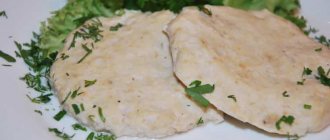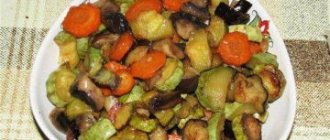Composition of zucchini and its nutritional value
The usefulness of zucchini is determined by the vitamins, micro- and macroelements it contains.
Nutritional value determines the amount of fat, protein and carbohydrates per 100 grams of vegetable product.
| Vitamins | Microelements | Macronutrients | The nutritional value |
| Vitamin C 15 mg | Iron 0.4 mg | Potassium 238 mg | Proteins 0.6 g |
| Vitamin H 0.4 mg | Calcium 15 mg | Carbohydrates 4.6 g | |
| Vitamin A 5 mcg | Phosphorus 12 mg | Fat 0.3 g | |
| Vitamin PP 0.6 mg | Sodium 2 mg | Water 93 g | |
| Vitamin B1 0.03 mg | Magnesium 9 mg | Fatty acids Saturated 0.1 g | |
| Vitamin B2 0.03 mg | Fatty acids Unsaturated 0.1 g | ||
| Vitamin B5 0.1 mg | Dietary fiber 1 g | ||
| Vitamin B6 0.1 mg | Organic Acids 0.1 g | ||
| Vitamin B9 14 mcg | Ash 0.4 g | ||
| Vitamin E 0.1 mg | |||
| Beta-carotene 0.03 mg | |||
| Calorie content: 24 kcal |
Useful properties of zucchini
Since the lowest calorie zucchini product is raw zucchini. This means it is safe to eat. 100 grams of fresh zucchini contains 30% of the required vitamin C. We need vitamin C for skin elasticity. It helps build the skin framework and maintains the elasticity of blood vessels. Vitamin C deficiency also manifests itself in the form of bleeding gums. Zucchini contains substances such as lignins. They prevent the development of breast cancer and diseases such as scurvy. Of course, heat treatment destroys vitamin C and other beneficial substances. But it still remains a low-calorie product. If you don't add a lot of oil. But fried zucchini cannot be called a low-calorie product.
Fried zucchini recipe and nutritional value
Ingredients:
- Zucchini – 500 grams;
- Egg – 2 pieces;
- Flour – 1 tablespoon;
- Vegetable oil – 100 g
Cooking method:
Cut the zucchini into circles, mix the flour and eggs thoroughly.
Dip each circle in a mixture of eggs and flour, fry in a frying pan with hot vegetable oil.
You can also spread each fried zucchini circle with mayonnaise and garlic; the calorie content of such a dish will be 94 kcal per 100 grams of product.
Calorie content of products and finished dishes:
| Product | Measure | Weight, g | Fats, g | Proteins, g | Carbohydrates, g | Calorie content, kcal |
| zucchini | 500 g | 500 | 1,5 | 3 | 23 | 120 |
| Egg | 2 pieces | 94 | 10,24 | 11,94 | 0,66 | 147,58 |
| Flour | 1 spoon | 25 | 0,3 | 2,3 | 18,72 | 85,5 |
| Vegetable oil | 100 | 99,9 | 0 | 0 | 899 | |
| Total per 100 g | 719 100 | 111,94 15,56 | 17,24 2,39 | 42,38 5,89 | 1252,08 174,14 |
Are fried zucchini healthy?
Zucchini, fried without oil, has low calorie content, therefore it is a dietary product and can be used on strict diets. The product retains almost all beneficial properties.
Due to the high content of vitamins, the product is recommended for people with vitamin deficiency. The fruits remove toxins from the body and maintain normal water-salt balance, and also relieve swelling. When consumed, intestinal motility increases and hemoglobin levels increase.
The dish has an antiallergic and antianemic effect. Due to the content of the strongest natural antioxidant, the product helps reduce the risk of developing cancer.
Zucchini fritters nutrition facts
Ingredients:
- Zucchini - 250 g;
- Flour - 2.5 tablespoons;
- Egg 1 - piece
- Vegetable oil - 20 ml
- Salt.
Cooking method:
Wash the zucchini well and peel off the skin with a knife.
Cut lengthwise, remove the inside, along with the seeds.
Scroll through a meat grinder, or take a medium grater and grate them.
Add eggs, salt, flour and mix everything thoroughly.
Heat the oil in a frying pan, spoon the zucchini mass into the pan, fry on both sides for 7 minutes.
Calorie content of boiled zucchini
Zucchini is one of the most common dietary products. Its calorie content is equal to cucumbers, lettuce and lettuce. Nutritionists recommend including this vegetable in the menu for people suffering from excess weight. When boiled, it is the most dietary, but you can also use it to prepare casseroles, stews, pancakes, and add it to soups and other dishes.
Benefit
Zucchini contains valuable components necessary for the normal functioning of the body. The high content of B vitamins, ascorbic acid, potassium, and pectin make them desirable for patients with diabetes and obesity.
For those who suffer from gastrointestinal diseases, boiled zucchini should become one of the main dishes in their diet. Its benefits are invaluable in the nutrition of older people: the vegetable has a beneficial effect on the functioning of the digestive tract and prevents the development of atherosclerosis.
How many calories are in fried zucchini?
Zucchini is a herbaceous plant. Zucchini comes from the genus pumpkin - this is the pumpkin family, and a variety of the most common pumpkin. Zucchini grows in bush forms. In fact, the homeland of zucchini is America, where zucchini was still grown 3000 BC.
But zucchini already appeared in Europe in the 16th century. We can say that at the moment zucchini is grown in countries. Zucchini fruits have a rather oblong shape. The zucchini itself can be either green, yellow or white. Zucchini has a very good effect on our digestion and, of course, skin health, while it is easily absorbed in the body. Fresh zucchini is used throughout the year for a clearly long time.
Approximately from spring until autumn. It’s just that greenhouse zucchini appears first and then everything else. Zucchini is a very tasty vegetable, which, by the way, is constantly used fresh, but for some reason various kinds of canned food are rarely made from them. We must say that the chemical composition of zucchini itself, regardless of the variety, is the same.
How many calories are in zucchini in different cooking methods?
- Raw zucchini - 24 kcal, per 100 g of product
- Boiled 24 kcal, per 100 g
- Stewed - 40 kcal, per 100 g
- Fried - 88 kcal, per 100 g
- Fried with garlic - 109 kcal, per 100 g
- Zucchini with cheese - 98 kcal, per 100 g
- Baked with butter - 100 kcal, per 100 g
- Baked in foil in the oven - 30 kcal, per 100 g
- Zucchini puree - 24 kcal, per 100 g
- Squash caviar - 97 kcal, per 100 g
- Zucchini soup - 22 kcal, per 100 g
- Zucchini pancakes - 56 kcal, per 100 g
- Stuffed zucchini - 105 kcal, per 100 g
- Zucchini cake - 64 kcal, per 100 g p.
- Zucchini juice - 24 kcal, per 100 g
Zucchini fried in oil
A fried vegetable has much more piquancy and flavor delicacy than a stewed one. The very fact of “frying” surprisingly attracts attention and arouses appetite. It’s not for nothing that there are different variations:
- cooking on an electric grill;
- smoking with a light smoke;
- oil application;
- garlic flavoring.
But we also must not forget about the numbers reflecting the energy content. Do you want to know how much it will be in calories per 100 g of finished dish? Then remember: 88 kcal (compare what happened in the case of stewing in water - only 24 kcal/100 g). There is something to think about.
Calorie content of zucchini with mayonnaise and garlic per 100 grams
The calorie content of zucchini with mayonnaise and garlic per 100 grams is quite large and amounts to 110 kcal. Per 100 gram serving:
- 1.2 g protein;
- 7.8 g fat;
- 8.6 g carbohydrates.
Read: Calorie content of dried coconut
Nutritionists do not advise getting carried away with such dishes. Contraindications to the use of such zucchini are chronic and aggravated diseases of the liver, gall bladder, stomach, intestines, excess weight, and high cholesterol.
Benefits of zucchini
Zucchini belongs to the pumpkin family.
This is an annual plant, the fruits of which can have different colors: from dark green to yellow. We are more familiar with light green zucchini, which ripen in our latitudes around mid-summer. In Europe, zucchini gained popularity in the mid-16th century. Then they began to actively use it both fresh and as a separate dish or as one of the ingredients in complex dishes. It is worth saying that with the addition of zucchini to a dish, the calories in it increase slightly. Zucchini does not carry any weight and if you cook it together with other vegetables, the dish will turn out light and satisfying. Together with the addition of zucchini, the dish will receive many useful substances. In terms of nutritional value, zucchini is close to cucumber. It contains almost all the vitamins and microelements necessary for a complete balanced diet. This is especially important considering that the calorie content of zucchini is not high at all, which means it can be eaten in almost unlimited quantities. This vegetable contains mineral salts, potassium and sodium salts, phosphorus, magnesium, calcium, iron, and sulfur. In addition, zucchini contains elements such as titanium, arsene, lithium, molybdenum, zinc, and aluminum.
Thanks to a certain ratio of sodium and potassium, zucchini copes well with the problem of excess fluid retention in the body. Regular consumption of zucchini can normalize the removal of fluid from the body. And this despite the fact that there are not many calories in zucchini. Therefore, you can absolutely safely make zucchini a regular guest on your table, even for those who count how many calories there are in zucchini.
Harm of zucchini
Eating zucchini should be avoided in case of exacerbation of pancreatitis, cholecystitis, diseases of the stomach and intestines. Fried vegetables are excluded from the diet if you are overweight and have high cholesterol.
Zucchini causes flatulence in some people. Sometimes allergic reactions to the product may occur in the form of skin rashes.
Read: Calorie content of red rice per 100 grams
Zucchini grown in unfavorable environmental conditions can be saturated with toxic salts of heavy metals. If you have kidney problems, check with your doctor about the possibility of including zucchini in your diet.
Calorie content of zucchini
Different foods have different energy values. For those who are losing weight, it is important to know the calorie content of food in order to correctly create a menu for the day in accordance with their needs. For an overweight adult, you need to reduce your calorie intake by 500 calories per day compared to your usual diet in order to start losing weight. Many nutritionists recommend increasing your consumption of vegetables, as they are relatively high in fiber, vitamins and minerals, but low in calories. In this article we will discuss the calorie content of zucchini and various dishes made from this vegetable.
Dietary zucchini dishes
Of course, the calorie content of raw zucchini depends largely on the variety. Few people dare to eat this vegetable raw. Although there are salad recipes in which zucchini is not cooked. But this is still exotic for Russian cuisine. In our country, zucchini is traditionally served fried, stewed or in the form of zucchini caviar.
If you simply boil the zucchini or cook it in a double boiler without adding other products, you will get a healthy and record-breaking low-calorie dish. The calorie content of boiled zucchini is 22-25 kilocalories per 100 grams. By grinding such a zucchini in a blender, you will get a vegetable mass that has rightfully won first place among complementary foods for infants.
Naturally, since this product is safe and necessary for children from six months old, then it will be quite useful for adults. But there are few of us who agree to simply eat boiled zucchini. For many, this dish is not very attractive in taste.
But we all love and enjoy eating squash caviar. The calorie content of squash caviar depends on the method of culinary processing of vegetable raw materials. If the squash is boiled, the color of the final product is quite light, and the calorie content of squash caviar in this case is only 70 kilocalories per 100 grams.
And if the vegetables are fried, the color of the caviar will be darker and the energy value will be higher. The calorie content of squash caviar in this situation is 90-95 kilocalories per 100 grams. The chemical composition of the product contains water (83 grams), carbohydrates (8 grams), dietary fiber (2 grams), fats (5 grams), proteins (2 grams).
The calorie content of squash caviar is much higher than just zucchini, since quite a lot of fat is added to it during production. It is the oil that gives the dish its calorie content. Each gram of fat contains 9 kilocalories, which is significantly higher than in proteins and carbohydrates.
Now different companies use different recipes for squash caviar. Very often sugar is added to it. This additive reduces the dietary properties of the dish. It is best to prepare caviar from zucchini yourself at home using proven recipes.
The calorie content of stewed zucchini is also largely related to how exactly they were prepared. To reduce the energy value of the dish, avoid adding oil when stewing, do not use flour or potatoes. If your dish consists only of stewed vegetables, then its calorie content will remain low.
On average, the calorie content of stewed zucchini is about 80 kilocalories per 100 grams. A dish prepared according to the following recipe will have this energy value. Take 300 grams of zucchini, 30 grams of olive oil, 200 grams of tomatoes, 1 egg, 30 grams of onion. Cut the zucchini into thin slices and fry in olive oil. Add peeled tomatoes. Simmer for 10 minutes. Beat in the egg and serve hot.
Zucchini for weight loss can be prepared in a special way. The most useful method can be considered cooking in the oven in foil. In this case, you will completely retain the microelements and beneficial properties of zucchini. There is no need to add oil when baking, so the calorie content of the dish will be low.
To cook zucchini this way, you need to cut the young zucchini into thin slices. Place it on foil, add spices and lemon juice. Then cover the top of the dish with a layer of foil. Bake in the oven for about 20 minutes over medium heat. The calorie content of zucchini in this case will be 30 kilocalories per 100 grams.
The vegetable is consumed extremely rarely in its raw form; there are only unusual salads where it is present “in its pure form.” The crushed mass without heat treatment is sometimes given to small children under one and a half years old as zucchini puree. It is mainly served stewed, fried or boiled; squash caviar is also often used on sandwiches. The calorie content of zucchini varies depending on the heat treatment.
For those on a diet, whether by choice or as prescribed by a doctor, it is best to stew the vegetable with other vegetables or on its own. Supplementing with flour, meat and large amounts of sunflower oil is not recommended.
If you simply boil this vegetable in a saucepan or cook it in a double boiler, its calorie content will not differ from its raw form. Without adding other products, you will get a lean and dietary dish from which you can eat and give your body the necessary amount of nutrients.
The calorie content of fried vegetables will be higher, because you cannot do without using vegetable oil. Depending on what kind of oil is used and whether other products are added to the dish, the calorie content increases to 40-90 kilocalories per hundred grams. The same story with baked zucchini - by adding additional elements and filling it with vegetable oil, you increase the energy value and make it less beneficial for your figure. Using vegetable olive oil this can be minimized, but overall it is insignificant.
Squash caviar
Boiled and processed zucchini will be light in color. The calorie content is also quite low - about 70 kcal per hundred grams of product. If caviar was made from fried vegetables, due to the presence of vegetable fats, the calorie content can increase to 95 kcal per hundred grams. You can tell that the vegetable has been fried by its color: the caviar turns out to be a richer, darker color.
When cooking caviar, fat is added, each gram of which contains approximately 9 kilocalories. When choosing squash caviar in the store, pay attention not only to the color, but also to the fat content in the composition. The product itself practically does not contain it. If the composition shows a high content, it means that a lot of it was added. Zucchini ceases to be a dietary product in such caviar.
Stewed zucchini
Very often the vegetable is stewed, because even when boiled, few people like its taste. When stewing, the calorie content increases by adding butter, flour, and potatoes. To avoid increasing the energy value, you should avoid adding it all or add it in smaller quantities. Instead of sunflower oil, you can use olive oil.
When you stew only vegetables, without meat and flour, the resulting calorie content of the dish is about 80-90 kcal per hundred grams. Stewed zucchini remains dietary in this case; you can safely eat it and not worry about excess weight. You can add onions, eggs and tomatoes to add richness to the dish and make an excellent low-calorie and nutritious stew.
How many calories are in zucchini?
Doctors recommend zucchini for weight loss. Dishes made from this vegetable are part of standard medical diets for overweight people. This is primarily due to how many calories are in zucchini per 100 grams. The glycemic index of a given product and its composition of the main nutritional components are also important. The calorie content of zucchini per 100 grams is low - only 20-23 kilocalories. This vegetable also has a low glycemic index. It is equal to 15, which means that the product has a negligible effect on blood sugar after eating.
Zucchini contains no fat at all, and this is also very important for those losing weight. Zucchini contains a large amount of ascorbic acid, B vitamins, nicotinic acid, pectin, and potassium. All these properties make dietary dishes from zucchini very desirable for patients with obesity, diabetes mellitus and in preventive nutrition. If you want to maintain your figure, lose weight, and improve your health, dietary zucchini dishes are for you.








